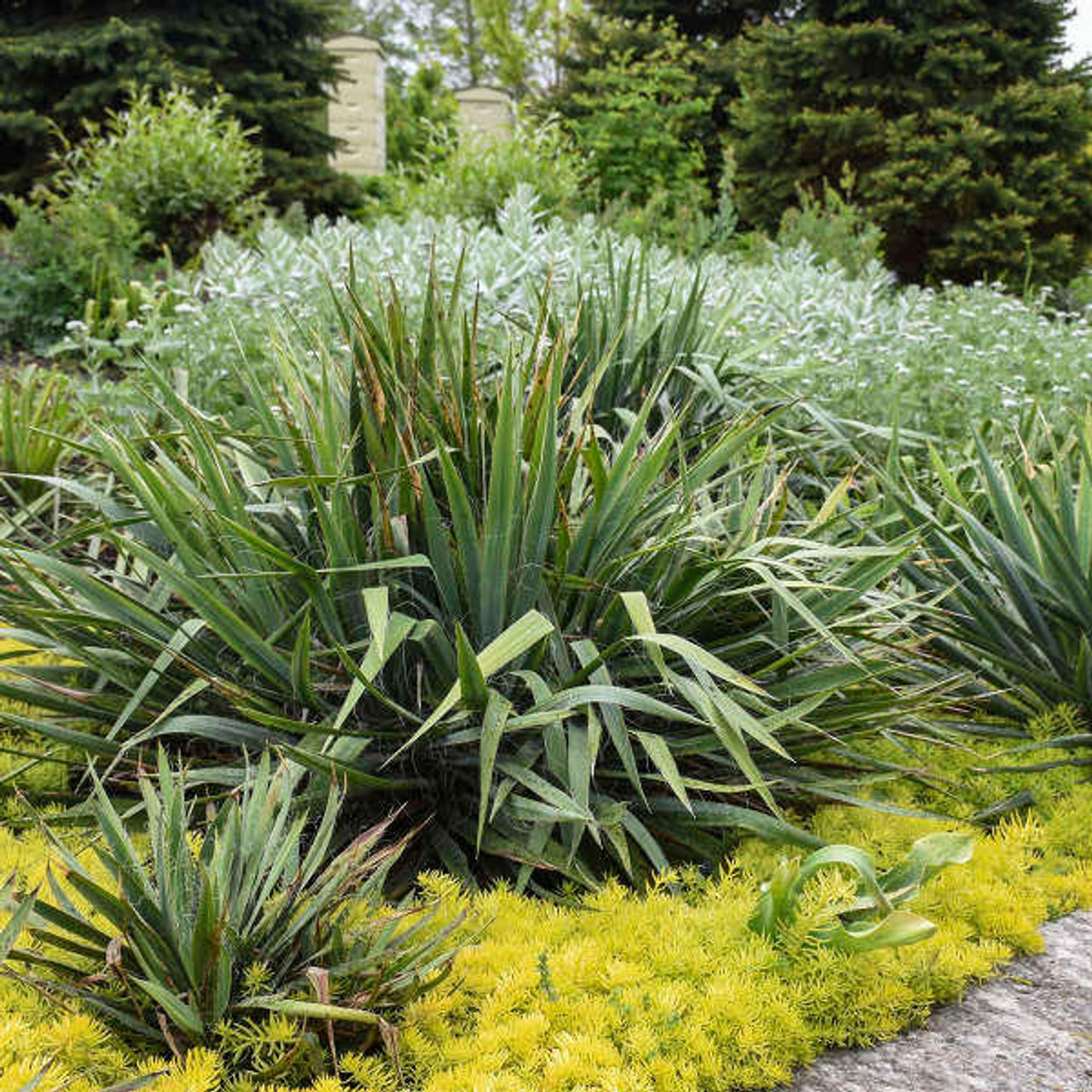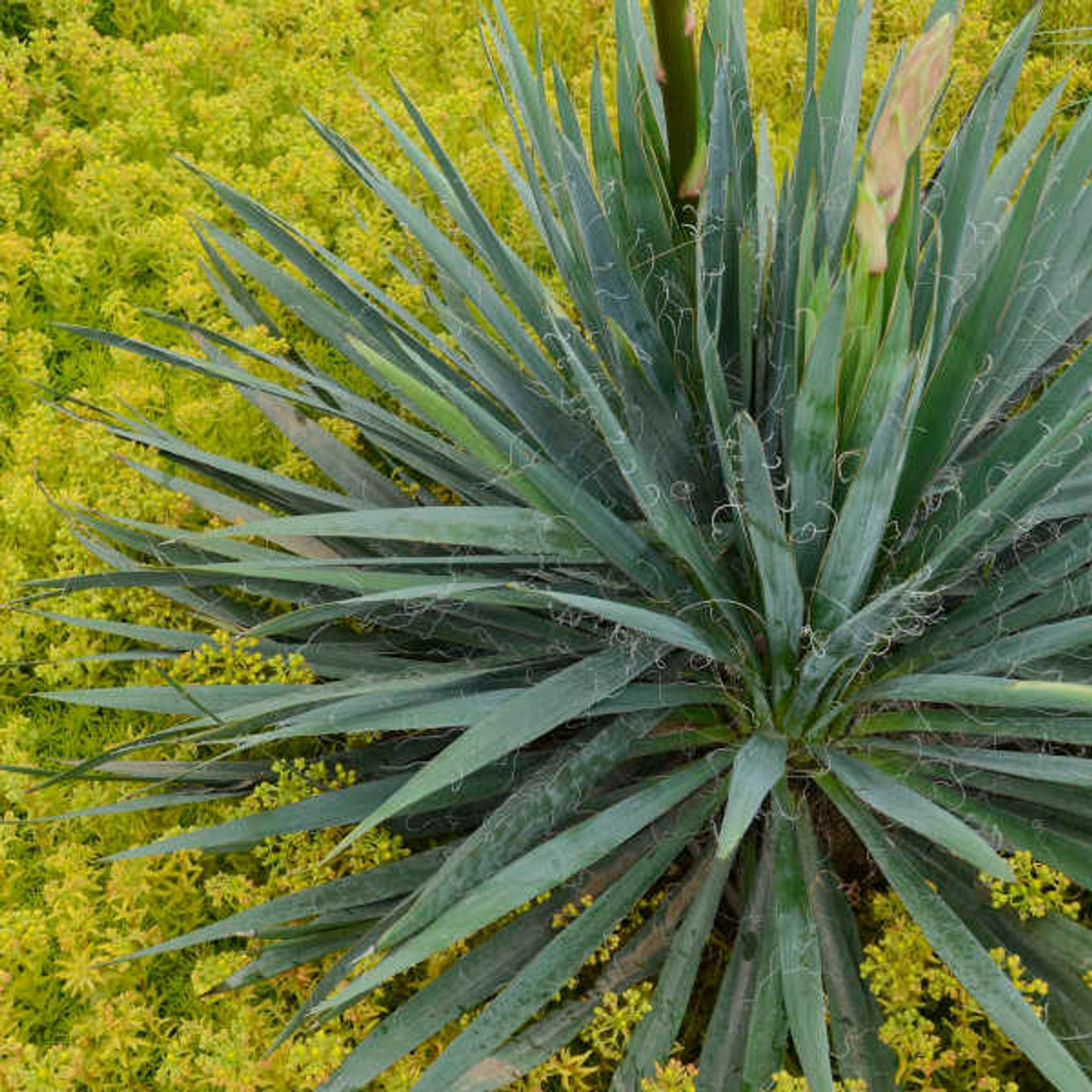Product Description
Yucca filamentosa 'Excalibur' (25) Bare Root Plants
Common Name: Adam's Needle
This Yucca forms a uniform, spiky, rounded clump of sword-like, blue-green to glaucous grey-green leaves lined with an extraordinary number of curly white filaments. Its habit is much more uniform and is overall smaller and compact than the straight species.
Impressively stout flower scapes carry white, bell-shaped flowers in early to midsummer.
Succulent in nature, Yucca do well in low water and rock gardens, tolerating dry soils that many other perennials do not. Tall flower scapes appear at maturity like elaborate candelabras. Grow these plants in full sun. Though they will grow in partial shade, they reach their full potential only if they receive sun all day long. Yuccas thrive in any type of well-drained soil including those that are very dry. Many yuccas do not bloom until they are mature. Once they start, though, you will see that they were worth the wait. The flower stalks retain some ornamental value after the blooms have faded. Mature plants sometimes develop plantlets near their base. These can be dug and transplanted elsewhere if desired.
Height: 1.5-2.0 Feet
Spread: 3.0-3.5 Feet
Scape Height: 4.0-5.0 Feet
Hardiness Zones: (4),5,6,7,8,9,10
Flower Color: White Shades
Foliage Color: Green shades
Full Sun (> 6 hrs. Direct Sun) - Part Shade (4-6 hrs. Direct Sun)
Low to Average Water Needs
Poor to Fertile Soil Quality
Bloomtime: Early Summer - Midsummer
Deer and Rabbit Resistant
Evergreen
Growth Rate: Medium
Border Plant, Container, Drought Tolerant, Easy To Grow, Salt Tolerant, Specimen, Focal Point
Yucca filamentosa 'Excalibur' is a striking cultivar of Yucca filamentosa, commonly known as Adam's Needle. This evergreen shrub, bred by American Beauties Native Plants , is an excellent choice for adding a unique architectural element to gardens. It is prized for its blue-green foliage, tolerance to drought conditions, and showy flower display.
Characteristics Yucca 'Excalibur' forms a tidy rosette of sword-shaped leaves with a distinctive blue-green to gray-green hue. The leaves are stiff and upright, edged with numerous curly white filaments that add textural interest. This slow-growing cultivar has a more compact and uniform growth habit compared to the species, Yucca filamentosa. It typically reaches a height of 1.5 to 2 feet and spreads 3 to 4 feet wide. In early to mid-summer, mature plants send up a dramatic flower stalk that can reach up to 5 feet tall, bearing panicles of creamy white, bell-shaped flowers, each about 2.5 inches long. These elegant blooms add a touch of drama to the landscape.
Growing Conditions Yucca 'Excalibur' thrives in a wide range of conditions. It prefers full sun and well-drained soil and is hardy in zones 4-10. It is exceptionally drought-tolerant once established, thanks to its deep taproot that allows it to access groundwater. While it prefers dry to medium moisture, it can tolerate poor, sandy soils and even a few hours of shade. It tolerates a wide soil pH range, thriving in acidic, alkaline, and neutral soils. It is also salt-tolerant, making it suitable for coastal gardens. For optimal growth and flowering, ensure it receives at least six hours of direct sunlight. Interestingly, this resilient plant can even survive under roof overhang and root-bound soils under trees , displaying its adaptability to challenging environments.
Planting and Care Yucca 'Excalibur' is remarkably low-maintenance, making it a great choice for busy gardeners or those new to gardening. Here is a guide to planting and caring for this resilient plant:
- Planting:
- Choose a location with full sun and well-drained soil.
- Dig a hole twice as wide as the root ball and just as deep.
- Position the plant in the hole, ensuring the top of the root ball is level with the ground.
- Backfill with soil, firming it gently around the roots.
- Water thoroughly after planting.
- Watering:
- During the first growing season, water deeply once every 1-2 weeks to encourage root development.
- Once established, rely mostly on natural rainfall, supplementing only during prolonged dry periods.
- Avoid overwatering, as this can lead to root rot.
- Fertilizing:
- Fertilize in spring with a balanced, slow-release fertilizer to promote healthy growth.
- Other Care:
- Remove spent flower stalks to maintain a neat appearance.
- Mature plants may develop plantlets near their base, which can be dug and transplanted to propagate new plants.
- Caution: Yucca 'Excalibur' has sharp spines that can be painful if planted near walkways.
- Toxicity: This plant is toxic to dogs, cats, and horses. Keep this in mind when choosing a location for planting, especially if you have pets or livestock.
Landscape Uses Yucca 'Excalibur' is a versatile plant with various landscape applications. Its architectural form makes it an excellent focal point in borders, rock gardens, and containers. It can also be used in mass plantings to create a dramatic effect or as a low-maintenance hedge. Its drought tolerance makes it ideal for xeriscaping and dry gardens. The plant's unique form and texture make it suitable for both formal and informal garden settings.
Wildlife Benefits Yucca 'Excalibur' is a valuable addition to wildlife-friendly gardens. It attracts pollinators such as bees, butterflies, and hummingbirds. It is also a larval host plant for skipper butterflies , providing a vital food source for these beautiful creatures. Additionally, it attracts moths, further contributing to the biodiversity of your garden.
Yucca filamentosa 'Excalibur' is a remarkable and versatile plant that brings a touch of the desert to any garden. Its distinctive blue-green foliage, edged with curly white filaments, creates a captivating textural element. The impressive flower stalks, reaching up to 5 feet tall, add a dramatic vertical accent to the landscape. This cultivar is a testament to the beauty and resilience of native plants, even in cultivated forms.
'Excalibur' is an excellent choice for gardeners of all levels, from beginners to experienced enthusiasts. Its low-maintenance nature, drought tolerance, and adaptability to various soil types and light conditions make it a reliable performer in a wide range of garden settings. Whether used as a focal point in a rock garden, a striking accent in a mixed border, or a key element in a xeriscape design, 'Excalibur' is sure to impress with its unique beauty and hardiness. Its suitability for both formal and informal gardens further adds to its versatility.
Furthermore, 'Excalibur' plays a valuable role in supporting local ecosystems by attracting pollinators and providing a habitat for skipper butterfly larvae. This highlights the importance of incorporating even cultivated varieties of native plants into our gardens to promote biodiversity. With its striking appearance, ease of care, and ecological benefits, Yucca filamentosa 'Excalibur' is a truly valuable addition to any landscape.
Other Details
The most important part of the plant is its root system. Healthy roots are the foundation of a healthy, vibrant plant. The type of plug container used is based on the specific needs of the plants. Perennials offered as bare root traditionally perform better when planted as bare root.Planted in a specialized mix, potted plants have well established root systems. Top growth stage will vary depending on the current life cycle and time of year when shipped. In Winter and early Spring dormant plants may be shipped. Dormant plants may be planted right away, even before the last frost date.
Most bare root varieties are field grown for at least one season, though Hemerocallis and Hosta are grown for two seasons. The bulk of the soil is removed during the harvesting process and the tops of most varieties are trimmed back to the crown. They are graded, packed in shredded aspen or sphagnum moss and stored in freezers until ready to be shipped.
See our Container Sizes and Bare Root Perennials pages for more information.
Plant information and care is provided in the Overview section, Plant Genus Page and general information is provided in the Planting Care & Guides. Additional questions can be asked on each Plant page.
Plant Spacing: Using the maximum mature spread or width of a plant to guide spacing, ensures space to grow to full size. To fill an area sooner, plant them closer together. Just remember, future thinning or transplanting may be needed.
Water: Keep a close eye on newly planted perennials, especially throughout the first growing year. Most early plant loss is due to too much or too little water!


















